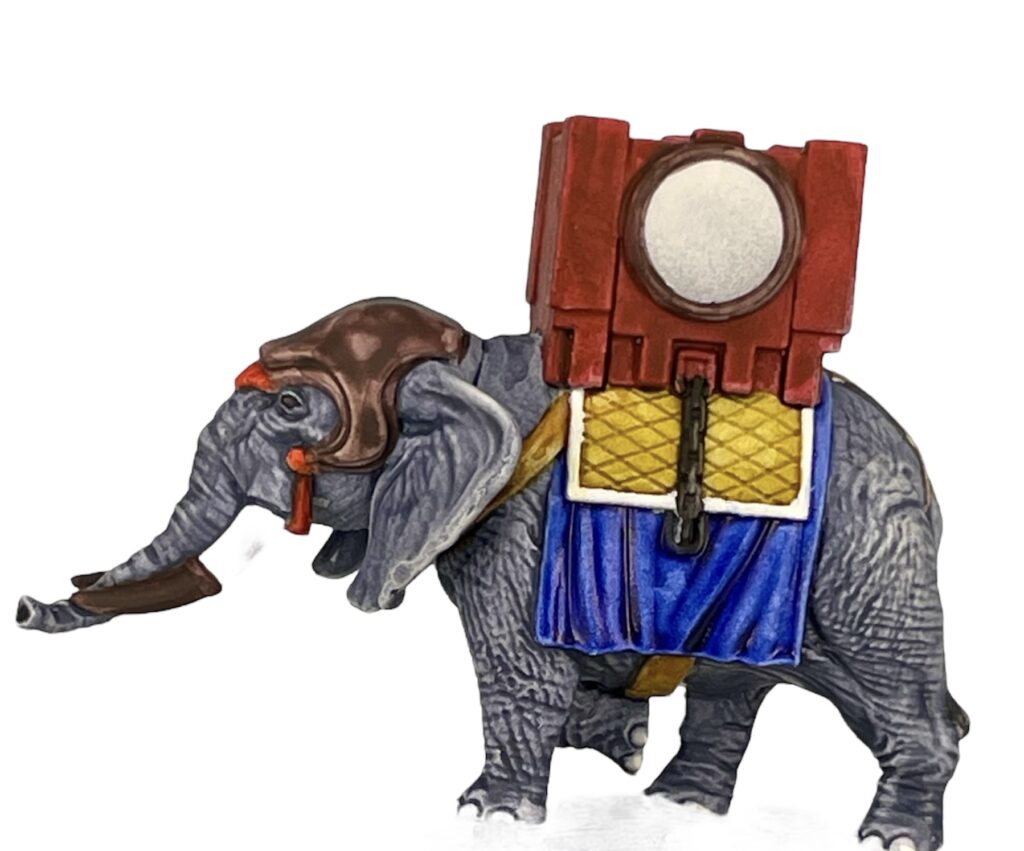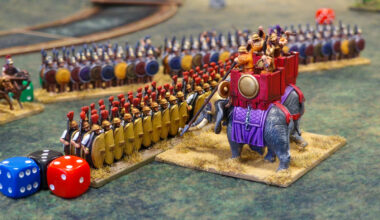For my second article in this series I simply couldn’t resist painting the Carthaginian war elephants! Each sprue contains two elephants (one armoured), five crew to be placed in the howdahs (the little castles on the elephant’s backs) and two mahouts (drivers). The elephants are multi-part but are easy to assemble and will result in a superb centre piece unit for any Carthaginian general.
I chose to paint my crew members separately from the elephant. For this process, I like to individually mount all my figures or strips on plastic bottle tops. I do this with blu-tack normally, but for the individual figures I attach them with superglue.
I cleaned up the figures as in my article on painting Numidians and again decided to use Vallejo Xpress Colors for all the base coats for this tutorial.
Elephants
I used Viking Grey applied in two coats for the elephant’s skin. You could easily leave the skin at this stage and it will result in a nice ‘tabletop standard’ finish. Although I think it looks fabulous, I resisted the temptation to apply pigmentation spots. These are more of a feature on Indian elephants, while the African species’ skin is more uniform in colour. I then lightly dry brushed the skin with Vallejo MC Ivory. Finally I glazed a thinned mix of the Viking Grey and water over the skin. This will blend the previous stage and produce a more pleasing result. If you are not familiar with ‘glazing’ it works in a similar way as a wash, but here the aim is to smooth the finish of the dry brushing and it should be applied so that it does not pool in the recesses. Final highlights with the ivory were done around the tops of the ears and around the eyes.
The howdah was given a coat of Citadel Seraph Red and then a thinner coat was applied. The paint was pushed into the recesses to provide a stronger contrast. The yellow part of the elephant’s blanket was done with Military Yellow and I painted the trim ivory. For the blue section I used two coats of Legacy Blue which resulted in a lovely finish. The straps were painted Wasteland Brown and any areas that were going to be bronze with Citadel Rhinox Hide and ‘silver’ with black. The tassels around the head armour were painted Plasma Red. With the metallics completed the elephant could be considered finished at this stage.

Highlights and Detailing
I edge highlighted the howdah with Citadel Wild Rider Red and then added tiny dots of Fire Dragon Bright at each corner. The blue blanket was highlighted with Citadel Calgar Blue.
The tusks and toenails were painted ivory and washed with Army Painter Soft Tone. Finally, highlights were applied with the original colour. The eyes and tail were then painted black and a small reflective dot of white was carefully placed in the centre of the eyes.
A thin line of either black or very dark brown was then applied at the boundaries of where colours meet. This ‘dark lining’ technique really makes each section of colour stand out.
Metallics
The bronze head armour was painted Vallejo Game Color Bright Bronze, and I used Vallejo Model Air Chrome for the chains attaching the howdah to the elephant’s blanket. I would not have used such a bright white metal on a larger scale miniature but with these smaller figures the aim is to really make them ‘pop’ on the tabletop.
The bronze was then washed with Liquitex Burnt Umber. I then edge highlighted the armour with Citadel Auric Armour Gold and applied thinned Bright Bronze to tidy up the highlights at the top of the armour. A little of the Auric Armour Gold was also applied here and to edge highlight the shields. I painted some Carthaginian designs on three of the shields to add a bit more interest to that part of the model. These basic techniques were also applied across the metallic areas for the riders too.

The Crew
The linothorax linen armour was painted Templar White and highlighted with ivory. I used the following colours for the cloth areas on the miniatures: Plasma Red, Legacy Blue, Seraph Red and Lizard green. The lighter red was highlighted with Fire Dragon Bright and the darker one with Wild Rider Red. For the blue I used Calgar Blue and for the green Citadel Moot Green. All areas of wood on the models were then painted Wasteland Brown. The skin was painted Tanned Skin and was highlighted with Citadel Cadian Fleshtone. I finished the model using the same dark lining technique I have described above using Citadel Rhinox Hide. The figures were then detached from the bottle tops with a hobby knife and the glue was scraped off their feet. This also exposed the bare plastic which ensured a better fit when they were glued onto the elephant. Place a bit of glue on both contact surfaces for a better join.

The second elephant and crew were painted with a very similar palette as the one I have described in detail. The only main difference is that I applied a lighter application of Viking Grey on the elephant’s skin to add a bit of variation in the unit and painted the howdah Space Grey.

Conclusion
By just using the Xpress or similar ‘speedpaint’-style colours as base coats across the miniatures you will achieve a nice tabletop standard, and then by applying extra details using the methods I have described above a more sophisticated finish can be achieved!
Inspired by Paul’s work? Pre-order your copy of Hail Caesar Epic Battles today and get in on the action!







3 comments
Nice
Keep up the painting and good work
Thank you
Comments are closed.